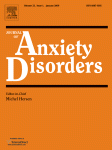
Sensitivity in Socially Anxious Youth: Implications for Treatment
A review of:
Anderson, E.R. & Hope, D.A. (2009). The relationship among social phobia, objective and perceived physiological reactivity, and anxiety sensitivity in an adolescent population. Journal of Anxiety Disorders, 23, 18-26
by Denise Fournier.
Research on social phobia has introduced a number of theories to explain the development and maintenance of this anxiety disorder. The existing research regarding the physiological differences between anxious and non-anxious youth has introduced possible explanations for the development and maintenance of anxiety experienced by socially phobic individuals. However, the research leaves many questions unanswered. The preponderance of research that has been conducted to study the evidence of physiological arousal in socially phobic individuals under anxiety-provoking situations has been conducted with adult samples, with only three studies having been conducted with a sample of children and adolescents. To attempt to provide clarity to the issue of physiological arousal and its manifestation in socially phobic youth, Anderson and Hope developed a study with the primary goal of investigating objective versus perceived physiological arousal and the differences in anxiety sensitivity between non-anxious and socially phobic adolescents.
The current study included a sample of 392 adolescents (213 girls and 179 boys) between the ages of thirteen and seventeen. Eighty five participants with social phobia were included in the study to investigate the differences in objective and perceived physiological arousal between the anxious and non-anxious adolescents. Anderson and Hope (2009) hypothesized that the adolescents with social phobia would exhibit greater increases in blood pressure and heart rate, and show higher levels of perceived physiological arousal and anxiety sensitivity than the non-anxious participants. The Beck Anxiety Inventory (BAI; Beck, Epstein, Brown, & Steer, 1988) was used to measure perceived anxiety and perceived physiological arousal during two anxiety-provoking tasks. Heart rate and blood pressure measurements were also assessed during each task.
The results of the study indicated no significant difference between the anxious and non-anxious participants on physiological arousal, as measured by heart rate and blood pressure. These results did not support the authors’ hypothesis that the anxious adolescents would experience greater increases in blood pressure and heart rate than the non-anxious adolescents in the study. The second hypothesis, that the anxious participants would evidence higher levels of perceived physiological arousal and anxiety sensitivity, was supported by the results of the study. Anderson and Hope (2009) surmise that it is possible that adolescents exhibiting social phobia show more self-focused attention, which makes them increasingly aware of the minimal physiological changes that take place during anxiety-provoking tasks.
The results of the present study indicate the need for further research on the manifestation of social phobia in adolescents. The inclusion of measures to assess self-reported anxiety serves as the primary strength of the current study, as it indicates the need for those who work with socially anxious youth to normalize the experience of physiological arousal during anxiety-inducing tasks. The ability to accurately measure changes in heart rate and blood pressure was limited as a result of a malfunctioning of the heart rate and blood pressure monitors that were used during the study. This malfunctioning may have affected the results, and future studies should attempt to more clearly identify the changes in blood pressure and heart rate between socially anxious and non-anxious participants.
Future studies on social phobia in adolescents should emphasize the significance of the difference in self-reported anxiety between anxious and non-anxious youth. Furthermore, the results of the present study invite future research to clarify the impact that a diagnosis of social phobia has on a socially anxious youth. The present study addresses the need to normalize the experience of physiological arousal during anxiety-provoking tasks. Implementing this finding in future attempts at treating social phobia can potentially lessen the fear of socially anxious adolescents that they will experience social embarrassment as a result of their anxiety.

 Sensitivity in Socially Anxious Youth: Implications for Treatment
Sensitivity in Socially Anxious Youth: Implications for Treatment
